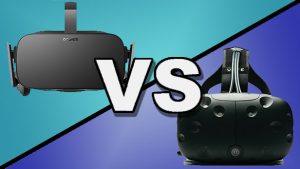Oculus Rift vs HTC Vive: Which is the best?
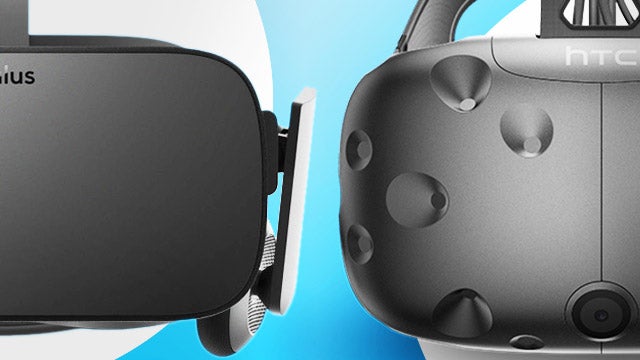
Both PC heavyweight VR headsets are out in the wild, so it’s time we put them through their paces to help you decide whether you should buy the HTC Vive or Oculus Rift.
When I first discovered that HTC was making a VR competitor to the Oculus Rift, I thought that the review I’d write of both products would take the form of a straightforward shootout.
The reality is very different.
BEST VR KIT PRICES:
- Buy Now: Oculus Touch Bundle, £399 at Currys
- Buy Now: HTC Vive with controllers, £599 at Currys
- Grab a VR-ready GPU for under £200, GTX 1060 at Amazon
Both the Oculus Rift and HTC Vive take great first steps in a world where virtual reality is commonplace, but having spent time with both I can attest that they take very different paths.
This makes deciding which is better a tricky proposition. Both have strengths and weaknesses but the nub is this: where you can walk around when using the HTC Vive, resulting in a more immersive and truly ground-breaking experience.
The Oculus Rift lets you play sat down for hours at a time, but the experiences are less incredible.
Of course, there’s far more to it than that, so read on to find out why both virtual-reality headsets are brilliant in their own ways.
Get Now: Oculus Rift with gaming PC bundle at Tesco from £1489
Related: VIVE Pro hands-on preview
Oculus Rift vs HTC Vive – Setup
One of the most obvious ways that the two VR headsets differ becomes apparent right from the start at setup.
It’s a given that you’ll need a very powerful PC to run both. Minimum requirements are similar, but you’ll also need to consider the space in which you’ll be using the device.
The Oculus Rift is a doddle to get ready. I plugged in the headset, sensor and Xbox One controller Wi-Fi stick, and was up and running in less than 10 minutes. I didn’t have a single sticking point on any of the three PCs I connected it to.
The HTC Vive is far more involved. For a start, there’s the space you’ll need to fully utilise it. HTC suggests 2 x 1.5m is enough; in our opinion the ideal room would be closer to 3m x 3m, which is a big investment if you don’t live in a mansion.
It comes with two sensors that need to be placed high and at opposite corners of the room. These require power and are supplied with mounting brackets, the idea being that you’d screw them into the wall permanently.
Video: HTC Vive unboxing
The headset itself also requires power, via a link box that connects it to the PC.
Once all the above is sorted, and you’ve run through the Vive’s lengthy installation process (including following such advice as “remove pets”), you’ll still have to update firmware on the headset and controllers.
With everything in place, I was good to go. Within minutes I discovered that the long cables often get in the way, and I regularly had to rearrange myself so as not to get too tied up when walking around.
The Oculus Rift is undoubtedly easier to set up, but the bigger issue is whether you have the space available to dedicate to the Vive. If the answer is no then its biggest advantage, being able to stand and move around, is negated.
Related: PlayStation VR review
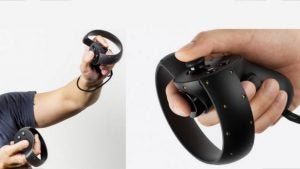
Oculus Rift vs HTC Vive – Controllers
Playing games in VR offers a totally different experience to using a TV or monitor. Having a 360-degree, three-dimensional environment means you can be far more involved.
There’s no doubt that the HTC Vive is able to take advantage of these incredible virtual worlds to a greater degree – and that’s mainly due to its controllers.
The Vive’s wireless controllers are a triumph in design and usability. You get two – one for each hand – and they’re visible, floating in the air, when you don the headset.
The triggers are in the perfect place for your index finger, making shooting games – such as Hover Junkers – a dream to play. There’s a clever button in the grip, too, that makes picking up objects feel intuitive; simply clench your fist.
Related: Oculus Rift vs PlayStation VR
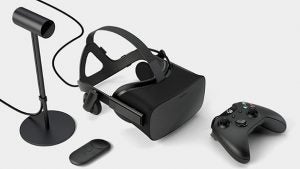
While I’m not a huge fan of the touch pads on the Steam Controller, they work brilliantly on the Vive. You can use them to flick through menus, plus they adapt depending on the application. This means you can have a scroll wheel for flicking through weapons, or make each corner of the pad a different button – it’s dead clever.
If I have any gripes it’s that the menu button is a bit of a stretch to reach, and I’d like more than the 4-5 hours of battery life.
By contrast, the Oculus Rift comes bundled with an Xbox One controller.
There’s nothing wrong with it, but it isn’t designed with virtual reality in mind – and it shows. Pure VR games such as Vanishing Realms and the upcoming Arizona Sunshine simply won’t work with it. However, it’s still excellent for sit-down gaming, such as the brilliantly addictive Eve: Valkyrie.
Oculus has designed its own Vive-like controllers, but they’re not yet available and will need to be bought separately when they do finally arrive.
The HTC Vive’s controllers are a great asset to the package and, if you have the space to take full advantage of them, serve to make the Vive a far more tempting proposition than the Oculus Rift.
Related: Oculus Touch review
Oculus Rift vs HTC Vive – Design and comfort
One of the major differences between the Vive and Rift is their design, with both headsets prioritising different aspects.
Everything about the Rift screams design with one thing in mind – lightness.
Like ultimate sports cars built for the track, it’s stripped down to the bare essentials while retaining strength and slick looks.
Touch fabric wraps around the lenses and a thin plastic cover on the front provides rigidity. It’s an austere look, but a handsome one. There’s only one control, which allows you to adjust the spacing of the lens.
Video: Oculus Rift unboxing
The straps on the headset are thin and light, too, enabling you to achieve a tight fit on your head, thereby minimising movement and rattle.
Even the built-in, on-ear 3D headphones are designed to shave off a few grams from the final weight of the headset.
By contrast, the HTC Vive is full of bells and whistles.
The lenses are clad in thick, dimpled plastic that in my opinion looks more stylish than that of the Rift’s finish. The Vive also features a front-facing camera, power off button and knob for lens adjustment.
It uses a similar system of velcro straps to fit heads of various shape and size, but these don’t go as far back on the head. Initially, this makes the Vive feel a little like it might fall off
your head. It won’t – but there’s certainly more movement on the head than there is with the Rift.
Both headsets use foam to provide a cushion for your face, but I preferred the thicker one on the Vive. I have a big nose, so was pleased to discover that both headsets sit well on my head and block out all light. However, testing them on those with daintier features I discovered gaps around the nose bridge that let in light.
The HTC Vive includes additional foam inserts and nose pads to resolve such issues, but the Oculus Rift doesn’t, so you’ll have to work something else out if it’s a problem.
While the Vive’s foam is thicker, it isn’t more comfortable than the Rift overall. The Oculus weighs 470g with headphones, where the Vive weighs 555g without headphones. That may not sound like much, but it is. I had no issues playing on the Rift for hours at a time; but I’ve found my neck straining following extended sessions with the Vive and headphones.
When it comes to design and comfort, the Oculus Rift comes out front – those integrated headphones sound great, without adding much weight to the overall unit.
Video: Trusted Explains – What is VR?
Oculus Rift vs HTC Vive – Games and software
The Oculus Rift comes bundled with Eve: Valkyrie and Lucky’s Tale. Both are polished games with plenty to offer – and Valkyrie, in particular, offers memorable moments of frantic gameplay.
The Vive’s freebies provide more of a showcase of its capabilities than games you’ll want to play for hours on end.
Fantastic Contraption lets you build machines to complete tasks, like a less violent version of Besiege. It’s great fun and gets the creative juices flowing.
Job Simulator, on the other hand, is brilliantly accessible for gaming and VR newbies alike, while Tilt Brush isn’t a game at all but rather an 3D canvas for creating beautiful “paintings”.
Watch the 10 best games on HTC Vive:
The HTC Vive’s bundled games are the more impressive initially, but you’ll get over the novelty pretty quickly. The Rift’s games, on the other hand, are a lot more involved, and I found myself frequently returning to Eve: Valkyrie in an attempt to improve.
Of course, these aren’t the only games you can get. Arguably, the HTC Vive’s strongest games have to be bought, and there are a couple of crackers that have proved to be a blast. Multiplayer shooter Hover Junkers is superb if a little rough around the edges, but my favourite is Vanishing Realms. Even though it’s still in early access, it provides a solid few hours of monster smashing.
It reminded me of Zelda on the Wii. You can fight with sword and shield, bow or magical staff, all of which require different moves with the controllers – and there were two occasions when I realised I was totally immersed.

The first was when I saw some gold beneath a spinning scythe. I went too close the first time and it knocked off my head, so I lay on the floor and crawled under it the second time. I don’t mean I made my character crawl; I mean I went down on my belly and inched my real body forward, all to get a few gold pieces because I wanted a better sword.
The second must have looked even more comical in real life. In classic RPG fashion, you can eat to recover health points. You do this by moving food in your hand to your mouth. I found a nice juicy apple and moved it towards my head and found myself opening my mouth – in real life – to take a bite. I’m just glad I was at home alone.
By contrast, most of the Oculus Rift’s games feel like they can be played on a normal monitor or TV as well. In some ways Chronos is similar to Vanishing Realms, and is a superb game in its own right – but the mere fact that it’s third person and using an Xbox controller makes it far less immersive.
That’s the core difference between these two headsets – their experiences are different. The Vive’s is the more impressive, when it works well, but I keep being drawn to the Oculus Rift for a proper evening of gaming.
Both headsets have their own portals to access games, although in the case of the Vive, you can also use Steam.
I found Oculus Home to be the slicker and easier to navigate and use. It isn’t perfect, but it’s better suited to virtual reality than Steam is currently.
Related: Oculus Rift vs HoloLens
Oculus Rift vs HTC Vive — Image and sound quality
The Oculus Rift and HTC Vive headsets pack very similar hardware specs. Both have dual OLED displays with a resolution of 1,080 x 1,200 per eye, both have a 90Hz refresh rate and 110-degree field of view, and both need very similar PC requirements to run.
Interestingly, I didn’t suffer any nausea with the HTC Vive – something that caused me to abandon using the Oculus Rift on occasion. I don’t think this has anything to do with the hardware, however.
Games on the Vive tend to use a fixed camera, whereas the games on the Rift were all first person, allowing me to rotate using the Xbox controller’s right analogue stick as well as look around.
Both headsets appear a little pixellated, but it’s possible to see more of the Vive’s sub-pixel array on occasion, meaning the red, green and blue lights of which the pixels are made are a little visible.
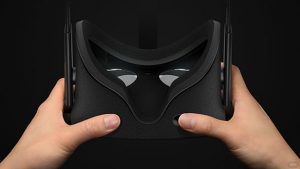
Due to the way the lenses wrap the screen, you also get some light-rays at the edges of your vision, but I find this less of an issue on the Vive. On the other hand, I find text easier to read using the Oculus; it seems to blur less when I move my head while reading.
Both headsets have their pros and cons when it comes to the screens, which makes them quite even. Neither is perfect – to achieve that both would require a significant boost in resolution.
For sound, however, the Rift is streets ahead. The attached headphones may not look like much – in fact, one of the TrustedReviews team compared them to airplane headphones – but they sound great and are very comfortable. If you don’t like them, you can remove them and use your own headset.
The HTC Vive comes with a pair of in-ear headphones that are attached to the headset via a 3.5mm jack. They sound okay, but proved annoying as they kept popping out. In the end, I opted to use my over-ear gaming headset instead. This improved the sound drastically, but also added more weight – I found my neck became tired soon after wearing the the Vive and headphones for more than half an hour at a time.
Get Now: Oculus Rift with gaming PC bundle at Tesco from £1489
Oculus Rift vs HTC Vive — Other Things to Consider
Of the two virtual-reality headsets, the HTC Vive is the more expensive at £689/$799; the Oculus Rift costs £499/$599. That’s a fair difference, and I’d also argue that the games bundled with the Rift with will keep you entertained for far longer than the Vive’s offerings.
However, those Vive controllers are awesome, and I expect the Rift’s motion controllers are likely to cost a fair sum when they’re released, making the price difference between the two headsets negligible.
The HTC Vive also comes with a front-facing camera that lets you see what’s going on in the real world. This is extremely useful and is a feature from which the Oculus Rift would benefit. On the other hand, the Rift has a sensor that recognises when the headset is no longer on your head – take it off and it will automatically pause the game you’re playing, which is neat.
Oculus Rift vs HTC Vive — Which should you buy?
Picking between these two virtual-reality headsets is tricky, but I’d say that it depends on how you want to experience virtual reality.
If you have the space to dedicate to it then the HTC Vive is the one to go for – no doubt about it. It provides the more incredible experiences, even if they’re short-lived, but you can use it like the Rift too, although it’s less comfortable.
If, on the other hand, you’re planning to play sat down then you should consider buying the Oculus Rift, and save a bit of money in the process.
Neither are perfect, yet, and nor should they be – this is the very start of true virtual reality following the numerous false dawns over the years. However, both are hugely impressive and will be a must-have for any tech-head. There’s also already a healthy catalogue of titles to keep you occupied, with many more great games in the pipeline.
(apester:568e54cd94a522de05776726)
What would be the first thing that you would do with a VR headset? Let us know in the comments below.


